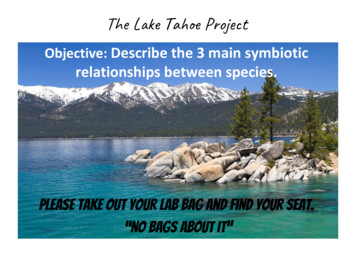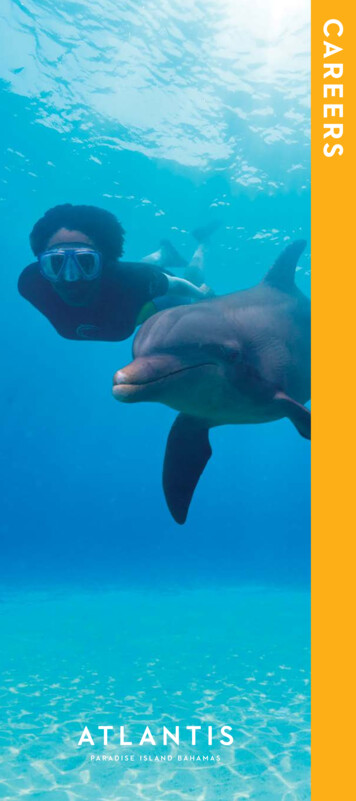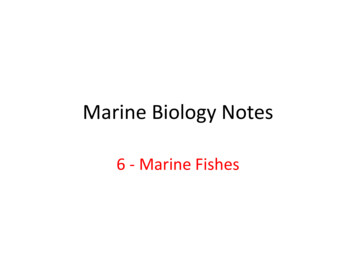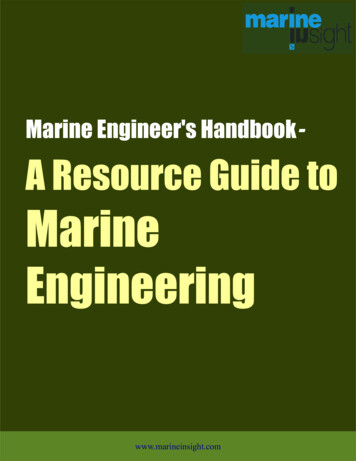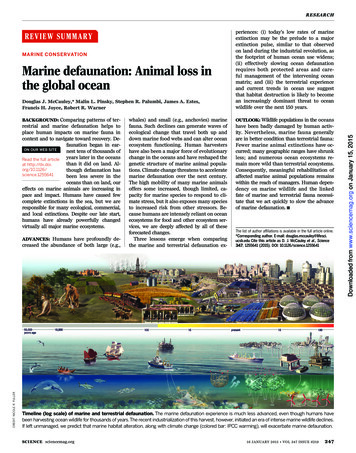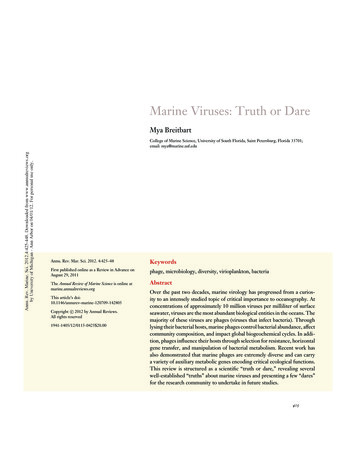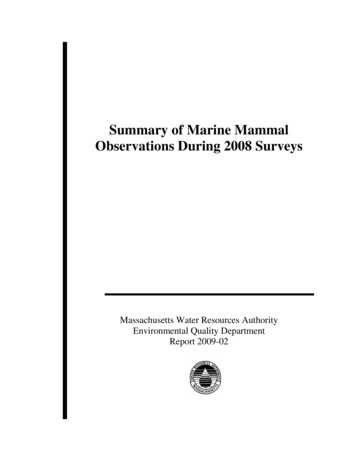
Transcription
Summary of Marine MammalObservations During 2008 SurveysMassachusetts Water Resources AuthorityEnvironmental Quality DepartmentReport 2009-02
CitationWu, D. 2009. Summary of marine mammal observations during 2008 surveys. Boston:Massachusetts Water Resources Authority. Report ENQUAD 2009-02. 19p.
Summary of Marine Mammal ObservationsDuring 2008 SurveysMassachusetts Water Resources AuthorityCharlestown Navy Yard100 First AvenueBoston, MA 02129prepared byDavid WuMarch 2009Report No. 2009-02
AcknowledgementsMarine mammal observers were individually contracted to assist Battelle in collecting the data containedin this report. The dedication and professionalism of David Silvia is appreciated.Thanks and appreciation are also extended to the captains, crews, and scientific personnel of theR/V Aquamonitor, R/V Tioga, R/V Andy Lynn VI, R/V Merganser, F/V First Light, R/V Key Largo, andF/V Windmere.Thanks to Matt Fitzpatrick of Battelle for compiling the mammal data
Marine Mammal Observation Report – 2008March 2009TABLE OF CONTENTS1.0Introduction. 12.0Background . 13.0Methods. 24.0Results. 45.0Discussion . 126.0Summary of Whale Sightings 1998 through 2008 . 137.0References. 17LIST OF TABLESTable 1. Marine Mammal Observer Sightings on 2008 MWRA Boston Harbor and Shellfish WaterQuality Surveys. . 6Table 2. Marine Mammal Observer Sightings on 2008 Nearfield and Farfield Surveys. 7Table 3. Whale Sightings by Area, Species, and Year. 14LIST OF FIGURESFigure 1. Location of Nearfield and Farfield Stations . 3Figure 2. Location of MWRA Surveys for Division of Marine Fisheries Shellfish Bed Monitoring. 5Figure 3. Approximate Locations of Whale Sightings during 2008 Surveys . 11Figure 4. Distribution of Sightings by Species and Area, 1998-2008. 15Figure 5. Total Sightings of Whales by Area, 1998-2008. . 15Figure 6. Distribution of Whale Sightings by Species, 1998-2008. 16
This page intentionally left blank
Marine Mammal Observation Report – 2008March 20091.0 IntroductionAt least five endangered species of whales are known to visit or inhabit the Massachusetts and Cape CodBay area (Environmental Protection Agency [EPA] 1993): the right whale, humpback whale, finbackwhale, sei whale (rarely observed) and blue whale (rarely observed). Several non-endangered marinemammal species are also found: minke whales, harbor porpoise, several dolphin species, gray seals, andharbor seals.Since 1995, Massachusetts Water Resources Authority (MWRA) has included marine mammal observerson monitoring surveys. The MWRA surveys are being conducted as part of the long-term Harbor andOutfall Monitoring Project designed to verify compliance with the discharge permit and to assess thepotential environmental impact of treated sewage effluent discharge into Massachusetts Bay. Theseobservers were included in response to a National Marine Fisheries Service (NMFS) request that MWRAprovide observational data and set a positive example by using observers to minimize the chances ofcollision with a right whale. In addition to looking for right whales, observers conducted observations forother marine mammals. On surveys where observers were not present, the chief scientist and field crewdocumented any incidental sightings of marine mammals.Marine mammal observers were present on all nearfield and farfield water quality surveys during 2008.Observers were not present on Boston Harbor surveys and bacteria surveys for shellfish water qualitymonitoring.2.0 BackgroundA brief description of when marine mammals are expected to be found in Massachusetts and Cape CodBays is presented and discussed below.The right whale (Eubalaena glacialis) is critically endangered. Based on historical sightings, rightwhales can be expected to visit Massachusetts and Cape Cod Bays throughout the year (Brown et al.2002), with peak abundance in February, March and early April (Hamilton and Mayo 1990). Over thepast four decades 72% of the catalogued population of right whales has visited Cape Cod Bay andMassachusetts Bay (Brown et al. 2002). For the period of 1978 through 1986, using photographedsightings of right whales collected from whale watch boats and research cruises, the total number ofindividually identified right whales in Cape Cod Bay ranged from a single animal in 1978 to 47individuals in 1986 (Hamilton and Mayo 1990). The use of the eastern portion of StellwagenBank/Wildcat Knoll by right whales has been noted during extended surveys by the Center for CoastalStudies (Brown et al. 2002).The humpback whale (Megaptera novaeangliae) is an endangered species of whale known to feed withinthe Gulf of Maine in the spring, summer and fall (Waring et al. 1999). Historic records indicate thathumpbacks have been documented on Stellwagen Bank from April through December (CeTap 1982;Geraci et al. 1989; NMFS 1991). However, distribution appears to correlate with prey densities (Waringet al. 1999). The amount of humpback whale use of the Stellwagen area varies periodically most likelybased on the availability of sand lance as prey (Payne et al. 1986; Payne et al. 1990; Weinrich et al.1997).The finback whale (Balaenoptera physalus) is considered to be an endangered species and is the mostabundant and frequently sighted of the endangered whales that visit Massachusetts and Cape Cod Bays(EPA 1993). Finbacks are sighted year round in the Stellwagen Bank area with a peak abundanceoccurring between the spring and fall (Pett and McKay 1990).1
Marine Mammal Observation Report – 2008March 2009The sei whale (Balaenoptera borealis) and blue whale (Balaenoptera musculus) are both endangeredspecies (EPA 1993). The sei whale is uncommon but is regularly sighted (Schilling et al.1992), while theblue whale is rarely sighted in Massachusetts and Cape Cod Bays (EPA 1993). Both blue and sei whalestypically remain in deeper water (more than 100 meters) and further offshore (CeTap 1982). However,sightings of these species in coastal areas may correspond to changes in prey distribution (Payne et al.1990, Wenzel et al. 1988).The minke whale (Balaenoptera acutorostrata) is a non-endangered species typically seen in theStellwagen Bank area during the spring, summer and fall (CeTap 1982; Pett and McKay 1990). Duringthe winter, minke whale sightings in New England appear to decline dramatically (Waring et al. 1999).The Atlantic white-sided dolphin (Lagenorhynchus acutus) is a species of dolphin found from centralwest Greenland to North Carolina (Waring et al. 1999). The Gulf of Maine stock of Atlantic white-sideddolphins is classified as strategic by the National Marine Fisheries Service (Waring et al. 1999).Sightings of these dolphins in the Stellwagen Bank and Cape Cod Bay areas are common in the spring,summer (Weinrich et al. 2001), and, to a lesser extent, the fall (Pett and McKay 1990).The Atlantic pilot whale or long-finned pilot whale (Globicephala melaena) is the largest species ofdolphin found in cool temperate waters off Labrador, Newfoundland, and in the St. Lawrence River withsporadic sightings as far south as Maryland and Virginia (Bulloch 1993). Pilot whales form schools of afew to many hundreds of individuals and are mainly found relatively close to shore. Pilot whaledistribution and abundance appear to be linked to the topography of the sea floor and the abundance oftheir primary food source, squid (Harrison and Bryden 1989).The gray seal (Halichoerus grypus) is a non-endangered species of pinniped found from Maine to LongIsland Sound (Rough 1995). A small, year round breeding population is known to occur on outer CapeCod and Nantucket Island (Waring et al. 1999). The majority of gray seal sightings in Cape Cod Bayand the Stellwagen Bank area occur during the winter and spring, although periodic sightings have beenrecorded in the summer (Center for Coastal studies unpublished data).Harbor porpoises (Phocoena phocoena) of the Gulf of Maine/Bay of Fundy stock are classified asstrategic by the National Marine Fisheries Service (Waring et al. 1999). Historic data indicate that harborporpoises can be found in the Stellwagen Bank area and Cape Cod Bay from December through June(Pett and McKay 1990).The harbor seal (Phoca vitulina) is a non-endangered species of pinniped commonly found in the nearshore waters around New England (Katona et al. 1993). Harbor seals are most frequently seen in theStellwagen Bank and Cape Cod Bay areas in the winter and early spring with sightings beginning in lateSeptember (Pett and McKay 1990).3.0 MethodsFigure 1 shows a map of MWRA sampling stations, nearfield and farfield. Marine mammal observationswere performed during all daylight hours while transiting during nearfield water column surveys, and whilethe vessel was on-station for sampling operations. During vessel transits, the observer continuously scannedthe sea surface from directly ahead to 90 degrees abeam on either side of the vessel. Initial sightings weremade by eye with confirmation and identification aided by binoculars. While on-station, the observerscanned 360 degrees around the vessel. The observer was typically positioned at the highest and most securevantage point of the survey vessel. Weather conditions, safety of the observer, and limiting interference withthe operation of the vessel and sampling team were all factors that influenced the position of the observer onboard the vessel. Three survey vessels were used as observation platforms during the course of the year.2
Marine Mammal Observation Report – 2008March 2009Figure 1. Location of Nearfield and Farfield Stations3
Marine Mammal Observation Report – 2008March 2009The observer’s eye-height above the sea surface was approximately 4 meters on the R/V Tioga and R/VAndy Lynn VI and 2.5 meters aboard the R/V Aquamonitor. Observations were conducted 40 minutes out ofevery hour and were suspended when visibility was reduced to zero or when darkness occurred.Several other vessels were also used to conduct surveys where marine mammal observers were not present.The scientific crew on board the R/V Merganser, R/V Key Largo, F/V First Light, and the F/V Windmereobserved marine mammals while on surveys. These vessels were used to conduct MWRA Boston Harborsurveys and bacteria surveys for shellfish water quality monitoring (Figure 2). Similar to the previous year,data from those surveys are included in this report.Vessel track, station sequence, and number of stations varied among cruises, due to the constraints ofweather, special survey requirements, or both.4.0 ResultsObservation of marine mammals on surveys designed and operated for the collection of water quality dataplaces limitations and constraints on the method of observation and on the conclusions that may be drawnfrom the data. Standard line transect methodology is not possible on such surveys, and different vessels(which vary the characteristics of the survey platform) were used during the year. Therefore it is notappropriate to use these opportunistic sightings to estimate animal abundance. The data provide usefulqualitative information concerning seasonal patterns and relative abundance within the same study area.During the 2008 monitoring year, the marine mammal observers, Battelle survey team members, andMWRA survey team members counted between 44-45 individual whales, one Atlantic white-sideddolphin, four harbor porpoises, and four unidentified porpoises. Included in the whale count were 13 rightwhales, ten humpback whales, five finback whales, four minke whales, and between 12-13 unidentifiedwhales. Whale sightings in 2008 were split almost equally between the Stellwagen Bank National MarineSanctuary and Cape Cod Bay. Between 17-18 whales were spotted in the Stellwagen Bank Sanctuary,and 18 were sighted in Cape Cod Bay. Seven whales were spotted in the vicinity of the nearfield and twoin the farfield (Figure 3). The total number of whales (44-45) sighted during 2008 was the most since2006 (53-57 sightings). Tables 1 and 2 summarize all the sightings of whales by survey staff in 2008.Additionally, all other sighting of marine mammals such as pinnipeds and dolphins are also included inthose tables. In addition to the whales, approximately 142 harbor seals, a single grey seal, one dolphin,and eight porpoises were also sighted during the year. The geographic distribution of whale sightings ispresented in Figure 3.4
Marine Mammal Observation Report – 2008March 2009Figure 2. Location of MWRA Surveys for Division of Marine Fisheries Shellfish Bed Monitoring5
Marine Mammal Observation Report – 2008March 2009Table 1. Marine Mammal Observer Sightings on 2008 MWRA Boston Harbor and Shellfish WaterQuality Surveys.Survey IDPC081R/V MerganserWQM2008R/V MerganserPC082F/V First LightWQM2008R/V MerganserPC083F/V First LightWQM2008R/V MerganserWQM2008R/V MerganserPC084R/V MerganserWQM2008R/V MerganserPC085F/V WindemerePC086R/V Key LargoPC087R/V MerganserPC088R/V MerganserPC089R/V MerganserWQM2008R/V MerganserPC08AR/V MerganserCSO2008R/V Key LargoWQM2008R/V MerganserCSO2008R/V Key LargoPC08BR/V MerganserDate/TimeNumberMammalLocationSighting CommentsObserverPresent01/24/080----No sightingsNo01/08/08 08501Harbor SealUpper Inner Harbor, BHWQMharbor surveyNo02/25/08 08154Harbor SealsSighted off George’s IslandNo02/29/08 09541Porpoise42 21.68 N71 02.73 W42 19.27 N70 55.38 W42 21.62 N71 01.70 WInner Harbor mouthNo03/11/080----No sightingsNo03/13/08 11071Harbor SealOff Thompson IslandNo04/04/08 09111Harbor Seal04/04/08 09181Harbor Seal04/22/08 08301Porpoise04/25/08 08452Porpoises05/22/08 1215106/10/0842 19.44 N70 59.78 W42 20.59 N71 00.48 W42 20.59 N71 00.48 W42 17.77 N70 47.74 WInner Harbor mouthNoInner Harbor mouthEn route from F25 to F14No42 22.65 N71 02.74 WUpper Inner Harbor, BHWQMharbor surveyNoFinback Whale42 22.44 N70 53.52 WEn route from F18 & F24No0----No sightingsNo07/1/08 10192Finback Whales42 24.84 N70 41.65 WSite N16No08/04/080----No sightings.No09/04/08 10201Finback Whale300m West of N02No10/06/081Harbor SealSite 140No10/08/08 12151Harbor SealEn route from F18 to F24, offNahant.No10/23/081Harbor Seal10/23/081Harbor Seal10/27/08 09401Harbor Seal10/27/08 10301Harbor Seal10/27/08 11101Harbor Seal10/27/08 10501Harbor Seal10/28/08 11051Harbor Seal11/03/08 10462Minke Whales42 42.75 N70 82.18 W42 18.22 N71 02.26 W42 24.42 N70 52.51 W42 22.14 N71 03.42 W42 21.66 N71 02.28 W42 23.13 N71 02.93 W42 20.40 N71 00.33 W42 18.22 N71 02.26 W42 19.00 N70 59.38 W42 23.10 N71 02.94 W42 23.06 N70 48.36 W6Mouth of Charles RiverNoInner Harbor off Pier 3Tobin BridgeSite 024NoSite 140South of Thompson IslandTobin BridgeNoSite N07No
Marine Mammal Observation Report – 2008Survey IDMarch 2009Date/TimeNumberMammal11/04/081Harbor Seal11/04/081Harbor Seal11/05/081Harbor Seal11/05/08 12511Harbor Seal11/13/08 08001Harbor Seal11/13/08 08051Harbor SealCSO2008R/V Merganser11/14/08 09001Harbor SealCSO2008R/V Merganser11/18/08 08151Harbor Seal11/18/08 10001Harbor Seal11/26/08 07251Harbor Seal11/26/08 07322Harbor Seals12/01/08 08351Harbor Seal12/03/08 08152Harbor Seals12/03/08 082012Harbor Seals12/12/08 09031Harbor SealWQM2008R/V MerganserCSO2008R/V MerganserCSO2008R/V MerganserCSO2008R/V MerganserCSO2008R/V MerganserPC08CR/V MerganserCSO2008R/V MerganserLocation42 21.99 N71 02.67 W42 20.21 N70 57.79 W42 17.17 N70 58.71 W42 20.06 N70 58.55 W42 20.38 N70 58.97 W42 20.46 N70 59.73 W42 20.69 N71 00.55 W42 20.60 N71 01.01 W42 23.13 N71 02.49 W42 22.40 N71 02.73 W42 23.18 N71 03.33 W42 21.97 N70 58.50 W42 20.36 N70 53.59 W42 20.36 N70 53.59 W42 23.20 N71 03.45 WSighting CommentsObserverPresentOff site 138NoOff Deer IslandQuincy Bay, off site 139NoSite 065Between Deer Island and LoganNoOff Logan AirportOff Logan Airport at mouth of InnerHarborNoOff Reserve ChannelNoOutside Chelsea RiverInner Harbor off Naval ShipyardNoAt mouth of Island End RiverWinthrop MarinaNoOff of Calf IslandNoOuter Brewster IslandMystic River upstream of TobinBridgeNoTable 2. Marine Mammal Observer Sightings on 2008 Nearfield and Farfield Surveys.Survey IDWF081WN081R/V Andy Lynn VIDate/TimeNumberMammalLocationSighting Comments2/12/080----No sightings2/17/080----No sightings2/21/08 17054Harbor Seals2/22/08 06251Harbor Seal2/22/08 064010Harbor Seals2/22/08 06409Harbor Seals2/25/08 073010Harbor Seals2/25/08 07302Harbor Seals42 18.82 N70 55.05 W42 15.22 N70 55.37 W42 18.84 N70 54.96 W42 18.84 N70 54.96 W42 18.88 N70 54.86 W42 18.88 N70 54.86 W7ObserverPresentS side of George’s IslandN side of Grape IslandYesS side of George’s IslandN side of Hull on Toddy RocksIn transit to N10In transit to N10
Marine Mammal Observation Report – 2008Survey IDWF082WN082R/V TiogaWN083R/V AquamonitorWF084WN084R/V AquamonitorMarch 2009Date/TimeNumberMammalLocationSighting Comments3/3/08 09551North AtlanticRight Whale41 56.97 N70 14.17 W0.25 miles from location3/3/08 10151North AtlanticRight Whale41 57.62 N70 14.68 W0.75 miles from location3/3/08 10251UnidentifiedBaleen Whale41 59.79 N70 15.37 WEither finback or sei whale; 0.25from location3/3/08 11251UnidentifiedBaleen Whale42 11.01 N70 19.66 W0.75 miles from location3/4/08 16256Harbor Seals42 18.78 N70 54.85 WN side of Hull on Toddy Rocks3/6/080----No sightings3/25/08 07255Harbor Seals4/9/08 07404Harbor Seals4/9/08 08107Harbor Seals4/9/08 09301Harbor Seal4/9/08 09501Harbor Porpoise4/9/08 11001Harbor Seal4/9/08 11108Harbor Seals4/9/08 11201Harbor Seal4/9/08 11251Harbor Seal4/9/08 11301North AtlanticRight Whale41 53.10 N70 28.89 W000 and 0.25 miles from location4/9/08 11351North AtlanticRight Whale41 52.38 N70 28.24 W000 and 1.5 miles from location4/9/08 11451North AtlanticRight Whale41 51.23 N70 27.37 W270 and 0.25 miles from location4/9/08 11501North AtlanticRight Whale41 51.06 N70 27.03 WStation F014/9/08 12102North AtlanticRight Whales41 52.00 N70 23.45 W020 and 1.5 miles from location4/9/08 12102North AtlanticRight Whales41 52.00 N70 23.45 W010 and 2.9 miles from location4/9/08 12151Harbor Seals41 52.41 N70 21.73 W270 and 0.1 miles from location4/9/08 12301North AtlanticRight Whale41 52.76 N70 20.40 WStation F324/9/08 12501North AtlanticRight Whale41 54.04 N70 15.11 W180 and 1.0 miles from location42 18.55 N70 55.13 W42 16.46 N70 55.86 W42 18.57 N70 55.49 W42 13.41 N70 42.26 W42 09.74 N70 39.81 W41 57.41 N70 33.07 W41 55.47 N70 31.38 W41 54.97 N70 30.94 W41 54.99 N70 25.96 W8Hauled out on Toddy RocksObserverPresentYesYes190 and 0.25 miles from location030 and 0.5 miles from location090 and 0.25 miles from location270 and 0.1 miles from location090 and 0.1 miles from locationOn rocks at Stage Point, Manomet090 and 0.1 miles from location270 and 0.1 miles from locationYes
Marine Mammal Observation Report – 2008Survey IDWF084 (cont.)WN084R/V AquamonitorAF081R/V AquamonitorWN086R/V AquamonitorAF082R/V AquamonitorAF083R/V AquamonitorWF087WN087R/V AquamonitorR/V Andy Lynn VIMarch ghting Comments4/9/08 14001UnidentifiedBaleen Whale42 02.71 N70 16.46 W090 and 1.5 miles from location4/9/08 14001UnidentifiedBaleen Whale42 02.71 N70 16.46 W070 and 1.5 miles from location4/9/08 14101Humpback Whale42 04.50 N70 16.71 W030 and 0.75 miles from location4/9/08 14101UnidentifiedBaleen Whale42 04.50 N70 16.71 W230 and 0.25 miles from location.Possible minke whale4/9/08 15201North AtlanticRight Whale42 09.93 N70 25.96 W180 and 0.75 miles from location.Was slapping tail.4/9/08 15301Finback Whale4/9/08 18301Harbor Seal4/10/08 08106Harbor Seals4/10/08 13301Humpback Whale4/10/08 13502Harbor Porpoises4/11/08 09551Harbor Porpoise4/11/08 12351Harbor Seal5/16/080----No sightingsNo5/21/080----No sightingsYes5/28/080----No sightingsNo6/3/08 10401Harbor Seal1.3 km NW of Station AF8No6/9/08 13151Humpback Whale6/9/08 13301Grey Seal6/9/08 13501UnidentifiedBaleen Whale42 07.00 N70 17.24 W2 km NW of Station F29. Possiblehumpback whale6/13/08 10471Harbor Seals42 17.87 N70 55.23 WHauled out on Toddy Rocks6/16/08 09011UnidentifiedBaleen Whale42 23.38 N70 45.11 W325 meters W of Station N16.Possible minke whale6/16/08 13293-4UnidentifiedBaleen Whale42 24.35 N70 25.59 W1.2 km N of Station F28942 11.07 N70 29.14 W41 18.60 N70 54.92 W42 20.64 N70 55.29 W42 25.35 N70 25.83 W42 23.12 N70 25.89 W42 23.46 N70 45.80 W42 21.28 N70 51.46 W42 32.92 N70 33.42 W42 07.00 N70 17.24 W42 07.00 N70 17.24 W000 and 0.25 miles from locationYes270 and 0.25 miles from location090 and 0.25 miles from location300 and 1.0 miles from location090 and 0.1 miles from location000 and 0.1 miles from location030 and 0.1 miles from location3.5 km SSE of Station F29100 meters NW of Station F29Yes
Marine Mammal Observation Report – 2008Survey IDAF084R/V AquamonitorWN089R/V AquamonitorWF08BWN08BR/V AquamonitorWN08CR/V AquamonitorWN08DR/V AquamonitorWF08EWN08ER/V AquamonitorWN08FR/V AquamonitorMarch 2009LocationNumberMammal6/24/08 09051Minke Whale6/24/08 10181Minke Whale6/24/08 12101UnidentifiedBaleen Whale42 25.39 N70 31.82 WNear Station AF67/22/080----No sightings8/18/080----No sightings8/19/08 10182HumpbackWhales42 20.22 N70 25.55 WSlightly NW of Station F12. Likelymother and calf8/19/08 10404HumpbackWhales42 25.22 N70 26.02 WSlightly SE of Station F28. Onewhale observed was first seen in19768/20/080----No sightings9/2/080----No sightingsYes9/29/080----No sightingsYes10/24/081UnidentifiedBaleen Whale42 07.58 N70 19.08 W--10/27/081Harbor Seal42 20.21 N70 55.54 WNext to #13 can in North Channel10/31/081Atlantic WhiteSided Dolphin42 23.37 N70 25.91 W--11/21/08 125012Harbor Seals11/21/08 12503Harbor Seals42 23.67 N70 45.39 W42 33.65 N70 39.63 W42 18.75 N70 54.69 W42 18.75 N70 54.69 W10Sighting CommentsObserverPresentDate/Time250 meters W of Station N16In transit to Station AF9NoYesYesYesToddy Rocks N of HullYesSE side of George’s Island
Marine Mammal Observation Report – 2008March 200971 0'0"W70 30'0"W70 0'0"W EE1E242 30'0"NE42 30'0"NEEEEEEEEEEEEE 1E EEE EEEEEE2EEE1EEEEEEEEEEEEEEEEEEEEEEEEEEEEEEEE E EEEEEEEEEEEEEEEE E EEEEE14#*1#*E2E#*EEEEEE")11YEE11E1#*E111Whale Sightings - 2008") Finback whale#* Humpback whale2 Minke whaleEY North Atlantic right whaleUnidentified baleen whaleE Survey stationsStellwagen Bank National Marine Sanctuary11E11EY 1YE11Y1Y 11EYYDepth (m)0 - 40 m40 - 70 m70 m71 0'0"W42 0'0"N42 0'0"N#*1E2Y21YEEY0 2.5 51015Kilometers70 30'0"WFigure 3. Approximate Locations of Whale Sightings during 2008 SurveysNote: The data displayed in this figure come from Tables 1 and 2 of this report.1170 0'0"W
Marine Mammal Observation Report – 2008March 20095.0 DiscussionUnlike statistically-based programs or programs that are specifically designed to search for whales, theMWRA sightings are opportunistic and do not follow dedicated and systematic line transect methodology(as mentioned in Section 4.0), therefore, observations are descriptive, not a statistically robust populationcensus.During 2008, about 143 pinnipeds were sighted. 142 of these were harbor seals and one was a grey seal.These sightings were an increase from 2007 when 96 pinnipeds were reported, and comparable with 2006when 136 pinnipeds were seen. For comparison, the numbers for 2005 to 2001 were 76, 303, 105, 138, and138, respectively. Furthermore, in years prior to 2001, only 20 to 60 pinniped sightings were madethroughout the survey area. Most observations of pinnipeds are when the vessel is transiting to and from thesurvey area; the pinnipeds typically resting upon rocks.Only one Atlantic white sided dolphin was seen in 2008. Also, surveys spotted four harbor porpoise andfour additional unidentified porpoise in 2008. To put these numbers into a historical context, about 19-26dolphins were sighted in 2007, similar to 2006 (24-31 dolphins), 2004 (27 dolphins), and 1998 (32dolphins). However, 2007 had an increase in dolphin sightings compared to both 2005, when a small podwas observed, and 2002 when 10-13 dolphins were sighted. For the years 1999, 2000, 2001, and 2003,dolphin sightings averaged between 50 and 112 , with 2003 recording the highest number of dolphins eversighted for these surveys.Since 1998, the Provincetown Center for Coastal Studies (PCCS) has conducted systematic surveys ofCape Cod Bay from January through mid-May. In 2008, aerial surveys by PCCS observed right whales inthe Cape Cod Bay area for 125 days. According to PCCS, this was considerably longer than in the pastfour years (92, 100, 97, and 90 days for 2007, 2006, 2005, and 2004 respectively). Additionally, throughphotographic identification, 148 different right whales were confirmed, along with a number of so farunidentified whales. This number is approximately comparable with the 161 unique individuals sightedin 2007. However, the numbers from 2008 and 2007 are twice the annual average of identifiedindividuals between 1998 and 2006. 47 right whales previously unseen in the Cape Cod Bay area werespotted in 2008. These observations suggest that the Cape Cod Bay area is becoming more attractive toright whales (Leeney et al., 2008).12
Marine Mammal Observation Report – 2008March 20096.0 Summary of Whale Sightings 1998 through 2008For the past 14 years, MWRA has collected and reported on the yearly sightings of marine mammalsmade during program surveys. The same methods have been used to collect whale sighting data over theyears, but other factors such as vessels used, areas surveyed and time at each site prevent the data frombeing used for quantitative statements regarding whale populations in Massachusetts and Cape Cod Bays.The most consistent aspect of the program is that stations were surveyed around the same time of the yearfor approximately the same number of days. The following text provides a summary and comparison ofthe MWRA whale sighting data over the last ten years (1998 through 2008). Data prior to 1998 have notbeen included in this report due to possible differences in data collection methods, changes in surveyteams, and variations in time spent in each area. Data for Boston Harbor collected by MWRA was notavailable prior to 2005; therefore, the data are not included in this comparison.For this comparison, the whale sightings were grouped into four areas: Nearfield (NF; all nearfield stations),Stellwagen Bank National Marine Sanctuary (SBNMS; SW1, SW2, SW3, and SW4; stations F12,F27, F28, and F29),Cape Cod Bay (CCB; F01, F02, F03, F32, and F33), andFarfield (FF; F05, F06, F07, F10, F13, F14, F15, F16, F17, F18, F19, F22, F23, F24, F25, F30,and F31).During 2008, approximately 29 survey days were spent in Massachusetts and Cape Cod Bays. TheNearfield area was visited at least 12 times during 2008 with a total of seven stations sampled on eachsurvey. Each survey was for one day with vessel time about eight hours per day (approximately 96hours/year).During the MWRA surveys from 1998 to 2008, 346-357 whales of at least four identified species andunidentified species were seen over the past eleven years (Table 2). The highest number of whales (59)was sighted in 1999, due in part to 24-27 finback whales being observed on Stellwagen Bank.13
Marine Mammal Observation Report – 2008March 200912FFCCBNF1Totals5SBNMSFFCCBNFTotals729 29 274SBNMSFFCCBNFTotals3132614SBNMSFFCCBNF5115 7241411135-611112-534127-102412 14134124272-353135Finback Whale Observations11712121131319Minke Whale Observations16 31115115214162177 Unidentified Whale Observations11214-64 1213211223175318Year531627 5920Totals54 19Note: Blank cell denotes no whales observed.TotalsTotalSightings1171251723Humpback Whale Observations1227320084Right Whale 0011999SBNMSFFCCBNFTotalsArea20001998Table 3. Whale Sightings by Area, Species, and Year.12113336887-93 213-14101710111-118 111135415355413114341217-8639-115 4151131335357 17411213444514 10161858 38-42 102814 90-94 346-357 Over half of the overall sightings (54% of the 346-357 ) were made within the boundary of StellwagenBank (Figures 4 and 5). The area with the second highest whale sightings from 1998 to 2008 was CapeCod Bay (24% of the 346-357 ). Cape Cod Bay had the highest number of right whale sightings (25 outof 33), with the highest concentration of sightings occurring in April 2008 when ten were noted. Anadditional 11% of whales were sighted just outside Stellwagen Bank western boundary (listed asFarfield). The Nearfield area, which lies over and around the outfall, had just over 11% of the total whalesightings, with minke whales being the dominant species, followed closely by unidentified whale species.14
Marine Mammal Observation Re
every hour and were suspended when visibility was reduced to zero or when darkness occurred. Several other vessels were also used to conduct surveys where marine mammal observers were not present. The scientific crew on board the R/V Merganser, R/V Key Largo, F/V First Light, and the F/V Windmere observed marine mammals while on surveys.

